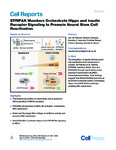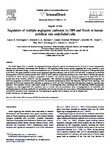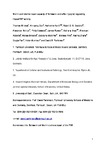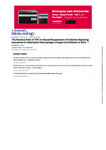STRIPAK Members Orchestrate Hippo and Insulin Receptor Signaling to Promote Neural Stem Cell Reactivation

Date
2019-06-04Author
Subject
Metadata
Show full item recordAbstract
Adult stem cells reactivate from quiescence to maintain tissue homeostasis and in response to injury. How the underlying regulatory signals are integrated is largely unknown. Drosophila neural stem cells (NSCs) also leave quiescence to generate adult neurons and glia, a process that is dependent on Hippo signaling inhibition and activation of the insulin-like receptor (InR)/PI3K/Akt cascade. We performed a transcriptome analysis of individual quiescent and reactivating NSCs harvested directly from Drosophila brains and identified the conserved STRIPAK complex members mob4, cka, and PP2A (microtubule star, mts). We show that PP2A/Mts phosphatase, with its regulatory subunit Widerborst, maintains NSC quiescence, preventing premature activation of InR/PI3K/Akt signaling. Conversely, an increase in Mob4 and Cka levels promotes NSC reactivation. Mob4 and Cka are essential to recruit PP2A/Mts into a complex with Hippo kinase, resulting in Hippo pathway inhibition. We propose that Mob4/Cka/Mts functions as an intrinsic molecular switch coordinating Hippo and InR/PI3K/Akt pathways and enabling NSC reactivation.
Collections
Publisher
Place of Publication
Journal
Volume
Issue
Pagination
Recommended, similar items
The following license files are associated with this item:
Related items
Showing items related by title, author, creator and subject.
-
Regulation of multiple angiogenic pathways by Dll4 and Notch in human umbilical vein endothelial cells.
Harrington, LS; Sainson, RCA; Williams, CK; Taylor, JM; Shi, W; Li, J-L; Harris, AL (United States, 2008-03)The Notch ligand, Dll4, is essential for angiogenesis during embryonic vascular development and is involved in tumour angiogenesis. Several recent publications demonstrated that blockade of Dll4 signalling inhibits tumour ... -
Merlin controls the repair capacity of Schwann cells after injury by regulating Hippo/YAP activity
Mindos, T; Zhang, He; North, K; Doddrell, RDS; Schulz, A; Edwards, P; Russell, J; Gray, B; Roberts, SL; Shivane, A; Mortimer, G; Pirie, M; Zhang, N; Pan, D; Morrison, H; Parkinson, David (Rockefeller University PressUnited States, 2017-01-30)<jats:p>Loss of the Merlin tumor suppressor and activation of the Hippo signaling pathway play major roles in the control of cell proliferation and tumorigenesis. We have identified completely novel roles for Merlin and ... -
The Possible Role of TGF-β-Induced Suppressors of Cytokine Signaling Expression in Osteoclast/Macrophage Lineage Commitment In Vitro.
Fox, Simon; Haque, LJ; Lovibond, AJ; Chambers, TJ (The American Association of ImmunologistsUnited States, 2003-04-01)<jats:title>Abstract</jats:title> <jats:p>Osteoclast formation is dependent on the ability of TGF-β to enable receptor activator of NF-κB ligand (RANKL)-induced commitment of hemopoietic precursors to the ...




